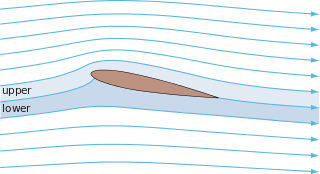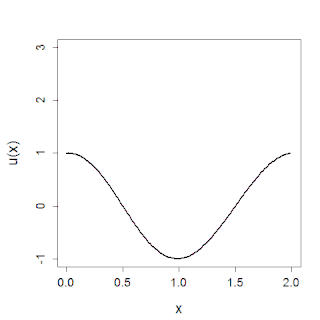General solution and complete integral
The general solution to the first order partial differential equation is a solution which contains an arbitrary function. But, the solution to the first order partial differential equations with as many arbitrary constants as the number of independent variables is called the complete integral. The following n-parameter family of solutions

is a complete integral if  . [1] The below discussions on the type of integrals are based on the textbook A Treatise on Differential Equations (Chaper IX, 6th edition, 1928) by Andrew Forsyth. [2]
. [1] The below discussions on the type of integrals are based on the textbook A Treatise on Differential Equations (Chaper IX, 6th edition, 1928) by Andrew Forsyth. [2]
Complete integral
The solutions are described in relatively simple manner in two or three dimensions with which the key concepts are trivially extended to higher dimensions. A general first-order partial differential equation in three dimensions has the form

where  Suppose
Suppose  be the complete integral that contains three arbitrary constants
be the complete integral that contains three arbitrary constants  . From this we can obtain three relations by differentiation
. From this we can obtain three relations by differentiation



Along with the complete integral  , the above three relations can be used to eliminate three constants and obtain an equation (original partial differential equation) relating
, the above three relations can be used to eliminate three constants and obtain an equation (original partial differential equation) relating  . Note that the elimination of constants leading to the partial differential equation need not be unique, i.e., two different equations can result in the same complete integral, for example, elimination of constants from the relation
. Note that the elimination of constants leading to the partial differential equation need not be unique, i.e., two different equations can result in the same complete integral, for example, elimination of constants from the relation  leads to
leads to  and
and  .
.
General integral
Once a complete integral is found, a general solution can be constructed from it. The general integral is obtained by making the constants functions of the coordinates, i.e.,  . These functions are chosen such that the forms of
. These functions are chosen such that the forms of  are unaltered so that the elimination process from complete integral can be utilized. Differentiation of the complete integral now provides
are unaltered so that the elimination process from complete integral can be utilized. Differentiation of the complete integral now provides



in which we require the right-hand side terms of all the three equations to vanish identically so that elimination of  from
from  results in the partial differential equation. This requirement can be written more compactly by writing it as
results in the partial differential equation. This requirement can be written more compactly by writing it as

where

is the Jacobian determinant. The condition  leads to the general solution. Whenever
leads to the general solution. Whenever  , then there exists a functional relation between
, then there exists a functional relation between  because whenever a determinant is zero, the columns (or rows) are not linearly independent. Take this functional relation to be
because whenever a determinant is zero, the columns (or rows) are not linearly independent. Take this functional relation to be

Once  is found, the problem is solved. From the above relation, we have
is found, the problem is solved. From the above relation, we have  . By summing the original equations
. By summing the original equations  ,
,  and
and  we find
we find  . Now eliminating
. Now eliminating  from the two equations derived, we obtain
from the two equations derived, we obtain

Since  and
and  are independent, we require
are independent, we require


The above two equations can be used to solve  and
and  . Substituting
. Substituting  in
in  , we obtain the general integral. Thus a general integral describes a relation between
, we obtain the general integral. Thus a general integral describes a relation between  , two known independent functions
, two known independent functions  and an arbitrary function
and an arbitrary function  . Note that we have assumed
. Note that we have assumed  to make the determinant
to make the determinant  zero, but this is not always needed. The relations
zero, but this is not always needed. The relations  or,
or,  suffice to make the determinant zero.
suffice to make the determinant zero.
Singular integral
Singular integral is obtained when  . In this case, elimination of
. In this case, elimination of  from
from  works if
works if

The three equations can be used to solve the three unknowns  . Solution obtained by elimination of
. Solution obtained by elimination of  this way leads to what are called singular integrals.
this way leads to what are called singular integrals.
Special integral
Usually, most integrals fall into three categories defined above, but it may happen that a solution does not fit into any of three types of integrals mentioned above. These solutions are called special integrals. A relation  that satisfies the partial differential equation is said to a special integral if we are unable to determine
that satisfies the partial differential equation is said to a special integral if we are unable to determine  from the following equations
from the following equations



If we able to determine  from the above set of equations, then
from the above set of equations, then  will turn out to be one of the three integrals described before.
will turn out to be one of the three integrals described before.
Two dimensional case
The complete integral in two-dimensional space can be written as  . The general integral is obtained by eliminating
. The general integral is obtained by eliminating  from the following equations
from the following equations

The singular integral if it exists can be obtained by eliminating  from the following equations
from the following equations

If a complete integral is not available, solutions may still be obtained by solving a system of ordinary equations. To obtain this system, first note that the PDE determines a cone (analogous to the light cone) at each point: if the PDE is linear in the derivatives of u (it is quasi-linear), then the cone degenerates into a line. In the general case, the pairs (p,q) that satisfy the equation determine a family of planes at a given point:

where

The envelope of these planes is a cone, or a line if the PDE is quasi-linear. The condition for an envelope is

where F is evaluated at  , and dp and dq are increments of p and q that satisfy F=0. Hence the generator of the cone is a line with direction
, and dp and dq are increments of p and q that satisfy F=0. Hence the generator of the cone is a line with direction

This direction corresponds to the light rays for the wave equation. To integrate differential equations along these directions, we require increments for p and q along the ray. This can be obtained by differentiating the PDE:


Therefore the ray direction in  space is
space is

The integration of these equations leads to a ray conoid at each point  . General solutions of the PDE can then be obtained from envelopes of such conoids.
. General solutions of the PDE can then be obtained from envelopes of such conoids.
Definitions of linear dependence for differential systems
This part can be referred to  of Courant's book. [3]
of Courant's book. [3]
We assume that these  equations are independent, i.e., that none of them can be deduced from the other by differentiation and elimination.
equations are independent, i.e., that none of them can be deduced from the other by differentiation and elimination.
— Courant, R. & Hilbert, D. (1962), Methods of Mathematical Physics: Partial Differential Equations, II, p.15-18
An equivalent description is given. Two definitions of linear dependence are given for first-order linear partial differential equations.

Where  are independent variables;
are independent variables;  are dependent unknowns;
are dependent unknowns;  are linear coefficients; and
are linear coefficients; and  are non-homogeneous items. Let
are non-homogeneous items. Let  .
.
Definition I: Given a number field  , when there are coefficients (
, when there are coefficients ( ), not all zero, such that
), not all zero, such that  ; the Eqs.(*) are linear dependent.
; the Eqs.(*) are linear dependent.
Definition II (differential linear dependence): Given a number field  , when there are coefficients (
, when there are coefficients ( ), not all zero, such that
), not all zero, such that  , the Eqs.(*) are thought as differential linear dependent. If
, the Eqs.(*) are thought as differential linear dependent. If  , this definition degenerates into the definition I.
, this definition degenerates into the definition I.
The div-curl systems, Maxwell's equations, Einstein's equations (with four harmonic coordinates) and Yang-Mills equations (with gauge conditions) are well-determined in definition II, whereas are over-determined in definition I.
Characteristic surfaces for the wave equation
Characteristic surfaces for the wave equation are level surfaces for solutions of the equation

There is little loss of generality if we set  : in that case u satisfies
: in that case u satisfies

In vector notation, let

A family of solutions with planes as level surfaces is given by

where

If x and x0 are held fixed, the envelope of these solutions is obtained by finding a point on the sphere of radius 1/c where the value of u is stationary. This is true if  is parallel to
is parallel to  . Hence the envelope has equation
. Hence the envelope has equation

These solutions correspond to spheres whose radius grows or shrinks with velocity c. These are light cones in space-time.
The initial value problem for this equation consists in specifying a level surface S where u=0 for t=0. The solution is obtained by taking the envelope of all the spheres with centers on S, whose radii grow with velocity c. This envelope is obtained by requiring that

This condition will be satisfied if  is normal to S. Thus the envelope corresponds to motion with velocity c along each normal to S. This is the Huygens' construction of wave fronts: each point on S emits a spherical wave at time t=0, and the wave front at a later time t is the envelope of these spherical waves. The normals to S are the light rays.
is normal to S. Thus the envelope corresponds to motion with velocity c along each normal to S. This is the Huygens' construction of wave fronts: each point on S emits a spherical wave at time t=0, and the wave front at a later time t is the envelope of these spherical waves. The normals to S are the light rays.

































































































